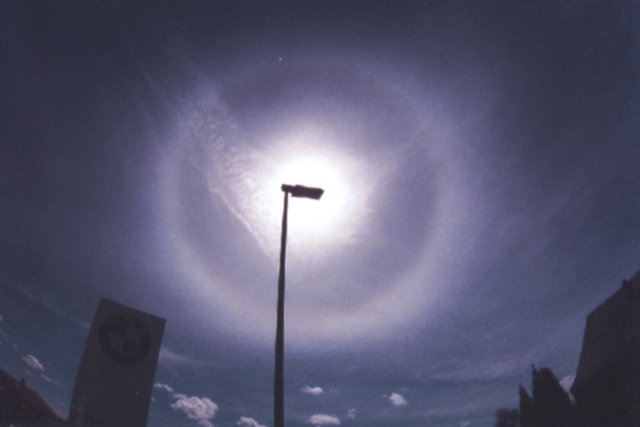- Crystal orientation:
- at random
- Path of light:
- 3-7
- Occurrence:
- very frequently
80-120 days a year
EE 01

Description:
The 22°-halo is a ring of light with a radius of 22° around the sun. Its reddish-brown inner rim has a relatively sharp edge. The outer rim, however, is white and diffuse. The 22°-halo is also called the little ring. But for a person who is not familiar with halos it appears to be gigantic. For a better orientation one can say that 22 degrees are more or less the angle between your thumb and your little finger when you reach out your hand and spread your fingers wide. The ring often cannot be seen completely. In most cases only the upper part is visible. In order to avoid being blinded by the sun, you should choose an observation point where the sun is hidden by some object, e.g. a street lamp.
Formation:
The small ring is the most frequent halo. It appears at almost any times when after a few sunny days a low pressure area approaches from the west. The forerunners of that low are cirrostratus and cirrus clouds which cover the sky. These let the sun shine through and look like a white veil of fog. Cirrostratus clouds are a very high altitudes. There the temperature is so low that water crystallizes on dust particles forming ice. The ice crystals are normally shaped like hexagonal prisms. They refract the sunlight like a 60-degree-prism. There are millions of these ice crystals in the cirrostratus layer. When the ice prisms are of about equal length and width or the atmosphere is very turbulent, they orientate at random. When the crystals are orientated at random the sunlight is refracted into all possible directions. But at an angle of 22° there results a clearly visible brightening because at this angle the direction of the light path in a rotating prism changes slower than at other angles. This angle is also called minimum deviation angle. The light enters one face of the prism and leaves the next but one. The light is refracted as well when entering and also when leaving the crystal. For red light the refractive index is smaller what causes the red inner rim of the 22°-halo. The formation of the 22°-halo is not subject to the suns altitude. Sometimes it is visible for several hours.


